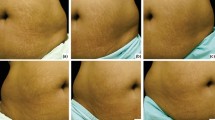Abstract
Striae distensae (SD) cause a cosmetic problem to many patients. Recently, fractional micro-needle radiofrequency (FMR) device has been introduced in treatment of SD. Also, fractional CO2 laser has been used as a resurfacing laser technique in the treatment of SD. The aim of our study was to assess and compare between the efficacy of FMR and fractional CO2 laser in treatment of SD. Seventeen female patients with SD were enrolled in this study. Detailed history was taken and dermatological examination was done to determine the type of striae, the location, and measurement of the width of the largest striae on each side. In each patient, one side was randomly assigned to treatment by FMR (area A), and the other side to treatment by fractional CO2 laser (area B). Our results showed that both techniques were effective. A slight better efficacy was encountered with FMR, but the difference was not statistically significant (p = 0.716). The current study concluded that FMR and fractional CO2 laser are almost equally effective in the treatment of SD (rubra and alba). Development of post inflammatory hyper-pigmentation (PIH) was evident with fractional CO2 in contrast with FMR, and the difference was statistically significant (p = 0.001).





Similar content being viewed by others
References
Ud-Din S, McAnelly SL, Bowring A, Whiteside S, Morris J, Chaudhry I, Bayat A (2013) A double-blind controlled clinical trial assessing the effect of topical gels on striae distensae (stretch marks): a non-invasive imaging, morphological and immunohistochemical study. Arch Dermatol Res 305(7):603–617
Cho S, Park ES, Lee DH, Li K, Chung JH (2006) Clinical features and risk factors for striae distensae in Korean adolescents. J Eur Acad Dermatol Venereol 20(9):1108–1113
Ghasemi A, Gorouhi F, Rashighi-Firoozabadi M, Jafarian S, Firooz A (2007) Striae gravidarum: associated factors. J Eur Acad Dermatol Venereol 21(6):743–746
Ud-Din S, McGeorge D, Bayat A (2016) Topical management of striae distensae (stretch marks): prevention and therapy of striae rubrae and albae. J Eur Acad Dermatol Venereol 30(2):211–222
Karia UK, Padhiar BB, Shah BJ (2016) Evaluation of various therapeutic measures in striaerubra. J Cutan Aesthet Surg 9(2):101
El Taieb MA, Ibrahim AK (2016) Fractional CO2 laser versus intense pulsed light in treating striae distensae. Indian J Dermatol 61(2):174
Ryu HW, Kim S, Jung HR, Ryoo YW, Lee KS, Cho JW (2013) Clinical improvement of striaedistensae in Korean patients using a combination of fractionated microneedle radiofrequency and fractional carbon dioxide laser. Dermatol Surg 39(10):1452–1458
Chan YH (2003) Biostatistics 104: correlational analysis. Singap Med J 44(12):614–619
Yang YJ, Lee GY (2011) Treatment of striae distensae with non ablative fractional laser versus ablative CO2 fractional laser: a randomized controlled trial. Ann Dermatol 23(4):481–489
Armenakas M, Rosenberg D, Renton B, Dover J, Arndt K (2010) Blinded, randomized, quantitative grading comparison of minimally invasive, fractional radiofrequency and surgical face-lift to treat skin laxity. Arch Dermatol 146(4):396–405
Cohen JL, Weiner SF, Pozer JN, Ibrahim OA, Vasily DB, Ross EV, Gabriel Z (2016) Multi-Center pilot study to evaluate the safety profile of high energy fractionated radiofrequency with insulated microneedles to multiple levels of the dermis. J Drugs Dermatol 15(11):1308–1312
Naein FF, Soghrati M (2012) Fractional CO2 laser as an effective modality in treatment of striae alba in skin types III and IV. J Res Med Sci 17(10):928
Pongsrihadulchai N, Chalermchai T, Ophaswongse S, Pongsawat S, Udompataikul M (2017) An efficacy and safety of nanofractional radiofrequency for the treatment of striae alba. J Cosmet Dermatol 16(1):84–90
Lee SE, Kim JH, Lee SJ, Lee JE, Kang JM, Kim YK, Bang D, Cho SB (2010) Treatment of striae distensae using an ablative 10,600-nm carbon dioxide fractional laser: a retrospective review of 27 participants. Dermatol Surg 36(11):1683–1690
Khater MH, Khattab FM, Abdelhaleem MR (2016) Treatment of striaedistensae with needling therapy versus CO2 fractional laser. J Cosmet Laser Ther 18(2):75–79
Author information
Authors and Affiliations
Corresponding author
Ethics declarations
Conflict of interest
The authors declare that they have no conflict of interest.
Additional information
Publisher’s note
Springer Nature remains neutral with regard to jurisdictional claims in published maps and institutional affiliations.
Rights and permissions
About this article
Cite this article
Sobhi, R.M., Mohamed, I.S., El Sharkawy, D.A. et al. Comparative study between the efficacy of fractional micro-needle radiofrequency and fractional CO2 laser in the treatment of striae distensae. Lasers Med Sci 34, 1295–1304 (2019). https://doi.org/10.1007/s10103-019-02792-7
Received:
Accepted:
Published:
Issue Date:
DOI: https://doi.org/10.1007/s10103-019-02792-7




